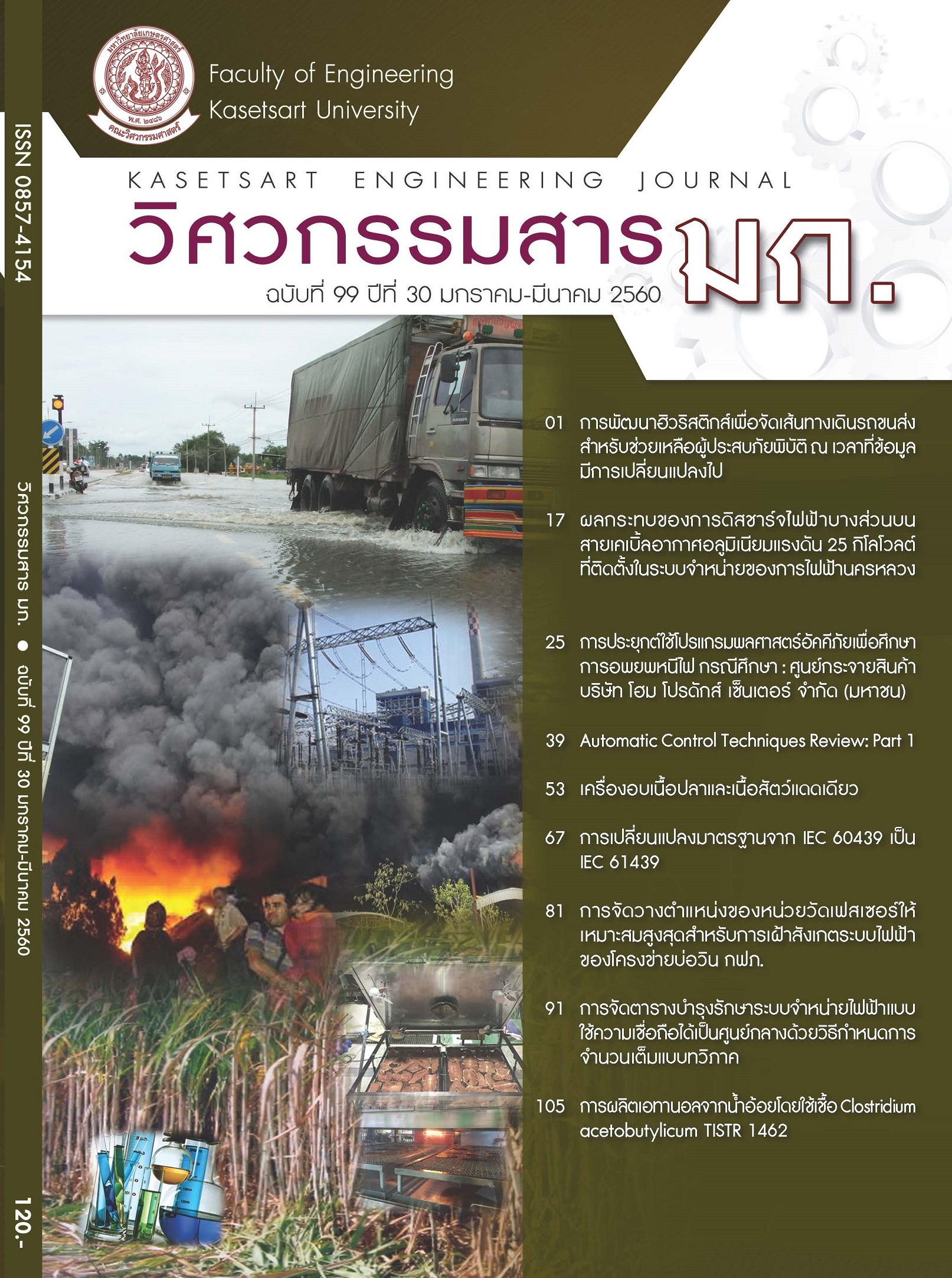การประยุกต์ใช้โปรแกรมพลศาสตร์อัคคีภัยเพื่อศึกษาการอพยพหนีไฟ กรณีศึกษา: ศูนย์กระจายสินค้า บริษัท โฮม โปรดักส์ เซ็นเตอร์ จำกัด (มหาชน)
Keywords:
การอพยพหนีไฟ, พลศาสตร์อัคคีภัย, ศูนย์กระจายสินค้า, Fire evacuation, Fire Dynamics Distribution CenterAbstract
บทความนี้แสดงผลการศึกษาการอพยพหนีไฟออกจากศูนย์กระจายสินค้าของบริษัท โฮม โปรดักส์ เซ็นเตอร์ จำกัด (มหาชน) โดยใช้โปรแกรม PyroSim 2014(Fire Dynamics Simulator with Evacuation) เพื่อนำผลที่ได้จากโปรแกรมไปวิเคราะห์และเสนอแนวทางการปรับปรุงแก้ไขลักษณะทางสถาปัตยกรรมภายในอาคารเพื่อลดข้อจำกัดและเพิ่มประสิทธิภาพให้กับการอพยพหนีไฟ การศึกษานี้ได้จำลองการอพยพในสถานการณ์เพลิงไหม้ภายในอาคารศูนย์กระจายสินค้าที่มีพื้นที่ทั้งหมด 115,132 ตารางเมตร มีผู้อพยพ 866 คน มีประตูทางออกทั้งหมด 42 ประตู มีระบบหัวกระจายน้ำดับเพลิง แต่สมมติให้ไม่ทำงานเพื่อกำหนดเป็นสถานการณ์ร้ายแรงที่สุด ในการศึกษามีการจำลอง 3 สถานการณ์คือ สถานการณ์ที่ 1 การจำลองสถานการณ์เพลิงไหม้โดยไม่มีการจำลองอพยพหนีไฟ จุดต้นเพลิงอยู่บริเวณห้องชาร์จแบตเตอรี่ที่ใช้ขับเคลื่อนรถยกรถลากสินค้า ซึ่งมีอัตราการปลดปล่อยความร้อน5 MW สถานการณ์ที่ 2 การจำลองสถานการณ์อพยพหนีไฟโดยไม่มีการจำลองกองเพลิงหรือกลุ่มควันไฟทั้งในและนอกขอบเขตการแพร่กระจายควันไฟ และสถานการณ์ที่ 3 การจำลองสถานการณ์เพลิงไหม้และการอพยพหนีไฟในพื้นที่ที่อยู่ในขอบเขตการแพร่กระจายของควันไฟ โดยจุดต้นเพลิงอยู่บริเวณเดิมจากผลการจำลองสถานการณ์ที่ 1 และ 2พบว่าการแพร่กระจายควันไฟในเวลา 300 วินาทีจะอยู่ในพื้นที่ Zone C และ Zone D ทำให้สามารถจำกัดการจำลองสถานการณ์เพลิงไหม้พร้อมการอพยพหนีไฟได้ใน Zone ดังกล่าว สำหรับการอพยพหนีไฟของ Zone A, B, C, D และ E ใช้เวลาในการอพยพ 127, 153, 177, 218 และ 127 วินาทีตามลำดับจากผลการจำลองสถานการณ์ที่ 3 พบว่าค่าเฉลี่ยของเวลาที่ใช้อพยพหนีไฟของแต่ละประตูจะเพิ่มมากขึ้นประมาณ 10 วินาที เนื่องจากปริมาณควันไฟที่สะสมอยู่ในอาคารส่งผลให้การมองเห็นลดลง ทำให้การเคลื่อนที่ช้าซึ่งกระทบต่อผู้อพยพโดยตรง จากผลการศึกษาและวิเคราะห์ทั้ง 3 สถานการณ์จึงนำไปสู่การปรับปรุงแก้ไขรูปแบบของศูนย์กระจายสินค้า โดยการเพิ่มความกว้างประตูจาก 1.0 เมตร เป็น 2.5 เมตร และจำลองสถานการณ์การเกิดเพลิงไหม้และการอพยพหนีไฟอีกครั้ง พบว่าการปรับปรุงดังกล่าวสามารถลดระยะเวลาที่ผู้อพยพคนสุดท้ายออกจากประตูลงไปได้ถึง 54 วินาที แสดงให้เห็นถึงขีดความสามารถในการอพยพที่เพิ่มมากขึ้น จากผลการศึกษาพบว่าเวลาในการอพยพอยู่ในเกณฑ์ที่กฎหมายกำหนด (น้อยกว่า 300 วินาที)และจากผลของพฤติกรรมการอพยพนั้นสามารถใช้ในการวางแนวทางการพัฒนาวิธีการอพยพให้มีประสิทธิภาพและมีความปลอดภัยมากยิ่งขึ้นได้
Application ofFire Dynamics Simulator for Study of Fire Evacuation Case Study: Distribution Center of Home Product Center Public Company Limited
This Article presents the study of Fire Evacuation for the case study of Distribution of Home Product Center Company by using PyroSim 2014 (Fire Dynamic Simulator with Evacuation Software), for taking the result from this program to analyze and present the revision way of interior architecture for reducing limitations, and increasing more efficiency of Fire Evacuation. In this study, fire situation was simulated within distribution center. The total area is approximately 115,132 square meters and nearly 866 employees are working in this place. There are 42 exit doors in total with fire extinguish system installed. The sprinkler line was intended not to be working to create disasters in worst case scenario. Three real life scenarios were simulated. The first scenario was set to have the fire without the fire evacuation. The fire had set to be started in the battery recharger room for Forklift Car. The released heat rate was 5 MW. The second scenario was set to have fire evacuation without burning source and smoke for both of inside and outside boundary of the diffusion smoke. Finally, the last scenario was set to have evacuation simulated in the same area where the fire started within the smoked area.
From the results obtained for the first two scenarios, the smoke had spread out in 300 seconds within the area of zone C and D. The results showed that both situations can be under control in those Zones. The evacuation times in zone A, B, C, D and E were in 127, 153, 177, 218, and 127 seconds.
The simulation result of the third scenario showed that an average time of each evacuation was increased by 10 seconds due to the massive smoke in the area which decreases visibility and slows down evacuee movement. The simulation results of all three scenarios had led to an improvement of the distribution center infrastructure. Exit doors were widen from 1 meter to 2.5 meters. Then, simulations were re-performed. As a result, evacuation time was decreased by 54 seconds which reflect better evacuation efficiency. From all the analyses above, the evacuation times were within the law’s regulation time (less than 300 seconds). This illustrates that the study of evacuation behavior can lead to the development of evacuation method for the increases in efficiency and safety


